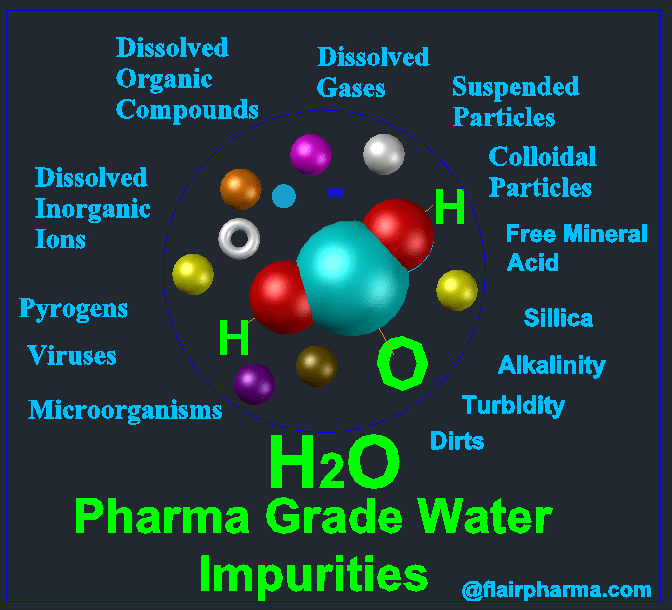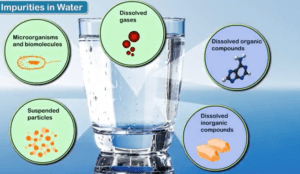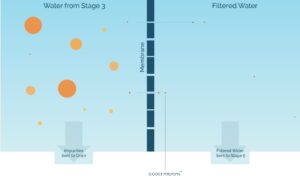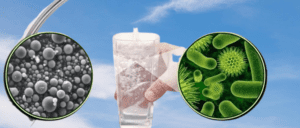Types of Impurities in Pharmaceutical water:
Pharma industrial has limited options for sources of water like river water, Surface water, or borewell water. So the pharma industries required pure water for their manufacturing processes. In this brief, we explain the impurities available in raw waters. Each impurity carries its own risks to chemical and biological research, not to mention the detrimental effect they cause on the quality of pure water.
Pharma companies analyze the following parameters of water:
| S.NO. | PARAMETERS | S.NO. | PARAMETERS |
| 1 | APPEARANCE | 16 | Sulphate |
| 2 | SMELL | 17 | REACTIVE SILICA AS SiO2 |
| 3 | TURBIDITY NTU | 18 | COLLOIDAL SILICA |
| 4 | SDI | 19 | TOTAL SUSPENDED SOLIDS ppm |
| 5 | Color HAZEN UNITS | 20 | BOD ppm |
| 6 | Conductivity @ 25°C µs/cm | 21 | COD ppm |
| 7 | Total Dissolved Solids, ppm | 22 | IRON CONTENT AS Fe |
| 8 | Ph | 23 | HEAVY METALS, IF ANY |
| 9 | Calcium as Ca | 24 | TOTAL ORGANIC CARBON, ppb |
| 10 | Magnesium as Mg | 25 | MICROBIAL COUNT CFU/ml |
| 11 | Total hardness as CaCO3 | 25.1 | PATHOGENS |
| 12 | Sodium as Na | 25.2 | PSEUDOMONAS |
| 13 | TOTAL ALKALINITY ( Alk M.) | 25.3 | SALMONELLA |
| 14 | Phenolpthalein Alk. (ALK P.) | 25.4 | E. COLI |
| 15 | Chloride | 26 | ENDOTOXIN Eu/ml |
Following are the Eight major contaminations: in Water:
Suspended Particles:
They are the bigger particles that are presented in water, in form of Clay, sand, silt, or vegetation, and have a size between 1 – 10µm. Generally, they cause turbidity and settle at the bottom of the storage tanks.
Colloidal Particles:
The colloidal particles are much smaller than suspended particles and have a size between 0.01 – 1.0µm. Generally, they don’t settle at the bottom of the tank so they are removed by media filters like MGF, ACF, or bag filters.

Microorganisms:
All Bacteria, algae, and fungi are also found in the water as Impurities. These microorganisms are the major cause of contamination which affects the quality of pharma water. By striving for the same enzyme-active locations on substrates, bacteria can negatively affect cell and tissue culture.
Also, free-floating bacteria form biofilms on surfaces of the pipeline or storage tanks. These biofilms can grow within the time period and spontaneously release bursts of bacteria, along with their associated endotoxins and nucleases. All these contaminations are checked in the microbiology lab.
Viruses:
Viruses also contaminate the water which is referred to as non-living nucleic acids and will adversely affect tissue and cell growth. Viruses are very small in size and most of them fall between 0.01 – 0.3 microns. Also, they have a long life.
Pyrogens:
Pyrogens are the metabolic products of microorganisms produced from living or dead organisms. These pyrogens increase the endotoxin in the water. Lipopolysaccharides can be harmful and raise the body’s temperature if they enter the blood or spinal fluid. pyrogen-free water is used in the pharmaceutical industry. Which causes lipopolysaccharides (LPS) n pharma water, which is derived from Gram-negative bacteria walls. Lipopolysaccharides can be harmful and raise the body’s temperature if they enter the blood or spinal fluid. pyrogen-free water is used in the pharmaceutical industry.

Dissolved Inorganic Ions:
Water is also contaminated by inorganic ions. Dissolved inorganic ions can take the form of silicates, chlorides, fluorides, calcium, phosphates, magnesium, bicarbonates, nitrates, sulphates, and ferrous complexes.
Dissolved Organic Compounds:
Animal and plant degradation, as well as any human activities that include the release of alcohol, protein, pesticides, chloramine, herbicides, or detergents into the environment, are all sources of dissolved organic compounds. Dissolved organic compounds are tested by the quality control lab through high-performance liquid chromatography (HPLC), gas chromatography, and fluoroscopy.
Dissolved Gases:
Gases that have dissolved Water contamination contain naturally dissolved carbon dioxide, nitrogen, and oxygen; however, these gases can change the pH of lab water, disrupting the ionic balance. Oxygen and nitrogen concentrations can influence the rate of biochemical reactions, and high concentrations of dissolved gases can cause bubble formation, obstructing flow through chromatography columns and micro-channels. Carbon dioxide dissolved in water raises the acidity of the water, reducing the capacity of ion exchange resins.

FAQ:
Do you know how pharma companies prevent contaminants in water?
Parma industries have a set up of water purification systems. Which primary means of preventing and removing contaminants and Impurities. Various technologies have been developed, each focusing on the removal of specific contaminants and all types of contamination and Impurities.
What are the major control instrument in the water system to measure purity?
- Online/ofline TOC analyser.
- TDS meter.
- Hardness Kit.
- Online/Offline Conductivity meters.
Conclusion:
Water contaminants or Impurities can be extremely harmful. They should be removed as soon as they are discovered, using the most effective form of water purification technology.
For more information on water system-related setup, please write us at: admin@flairpharma.com


1 thought on “Types of Impurities in Pharma water & its scream 22”